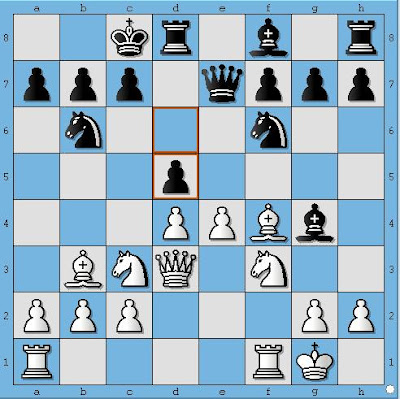Changing the roadmap.
According my latest approach to the game, there are 3 main elements to consider:
This sheds new light on an old question about steerability of a game. The roadmap is determined by the pawns. If there are no pawns, no road is blocked and you can move your pieces freely across the board. The amount of open roads has a great influence on the amount of possible moves (of the pieces, we are talking about here) hence at the complexity of the game. Have a look at the following position of a game of Margriet.
Diagram 1

.
.
.
White to play exd5 or e5.
Of course there are other and better moves than exd5 or e5 here. But that is not what I am investigating at this moment.
1. exd5 opens up the game and adds complexity. If black is a better calculator than white then his chances increase, allthough he is still worse, of course. It makes the game more of a gamble.
With 1. e5 more roads are, or continue to be, blocked. But is has another advantage in stead, it gains space. And hence manoeuvrability. The manoeuvrability of black is diminished while that of white has improved. This means that your chances have increased.
- The targets.
- The attacking pieces.
- The roadmap with the roads across which the attacking pieces get access to the targets.
This sheds new light on an old question about steerability of a game. The roadmap is determined by the pawns. If there are no pawns, no road is blocked and you can move your pieces freely across the board. The amount of open roads has a great influence on the amount of possible moves (of the pieces, we are talking about here) hence at the complexity of the game. Have a look at the following position of a game of Margriet.
Diagram 1

.
.
.
White to play exd5 or e5.
Of course there are other and better moves than exd5 or e5 here. But that is not what I am investigating at this moment.
1. exd5 opens up the game and adds complexity. If black is a better calculator than white then his chances increase, allthough he is still worse, of course. It makes the game more of a gamble.
With 1. e5 more roads are, or continue to be, blocked. But is has another advantage in stead, it gains space. And hence manoeuvrability. The manoeuvrability of black is diminished while that of white has improved. This means that your chances have increased.
Playing e4-e5 blocks in the Nc3 and Bb3. It blocks the Bf4 on the h2-b8 diagonal, and takes away the only central jump square for the Nf3. Mobility for white goes down hill after e4-e5.
ReplyDeleteThis sounds like "hope chess". A term by Dan Heisman. Playing "hope chess" makes you stuck at your current level. One has more chance of improving by analysing the specific features of the position, looking at possible plans for both sides, and developing concrete variations. All three steps are missing. In the broad analysis I would expect mention of the opposite castling, better piece development for white, more central control. In the specific analysis I would note that the black queen and rook are on the same diagonal. If white plays e5 then the knight should move. For instance one variation could be: 1.e5 K5 2.Bg5 f6 3.Bh4 and black is in troubles. White threatens Rae1.
ReplyDeleteWow, my posts must be really cryptic:)
ReplyDeleteHoi Tempo,
ReplyDeleteVolgens mij heb je echt een olifantenhuid nodig om eerlijk over je eigen pogingen te schrijven...
groet,
papablanca
Hi Tempo,
ReplyDeleteI know you are very interested in training and improvement.
I thought you would find this interesting.
http://thetalentcode.com/2010/02/22/are-you-in-the-zone-take-this-test/
Take care,
Jim "Takchess"
Thanks, Jim.
ReplyDeleteGood to see you hanging around, even with shifted focus.
I guess one has to weigh off the pro's and cons and offcourse it also has a little to do of what style of player you are. An attacking player will with no doubt in his mind immediatly play exd5 while a positional player will play more safely and will spend more time into calculating the difference between exd5 and e5.
ReplyDeleteAs being more a positional player myself i think i would go for e5 for reasons that i can always push it if i want to since no black pawn can block its progress and so can release all the strenght of the pieces it now so call blocks (Bf4 and Nf3) and it gains space + more importantly i dont give black a point of attack which after exd5 will be the d4 pawn.
But then again, what do i know, i am only a patzer in chess, so take all what i have said above with a grain of salt.
Of those moves I would play e5. I don't want to let black start placing pieces on d5.
ReplyDeletee5, no question, except for how much time do you want to lose off your clock and thereby do your opponent a big favor.
ReplyDeleteI have heard the term "hope chess" going back at least 10 years, not sure who coined it.